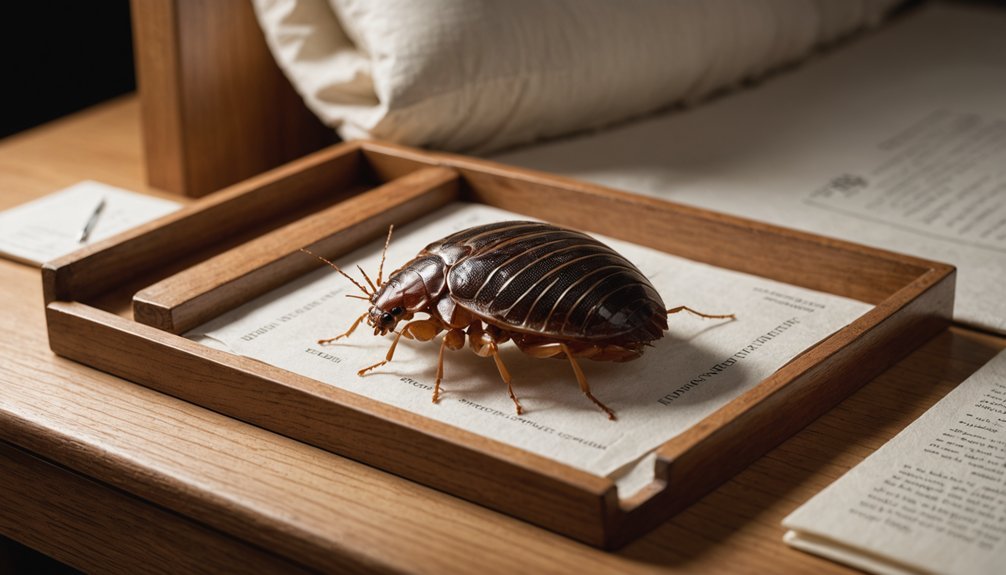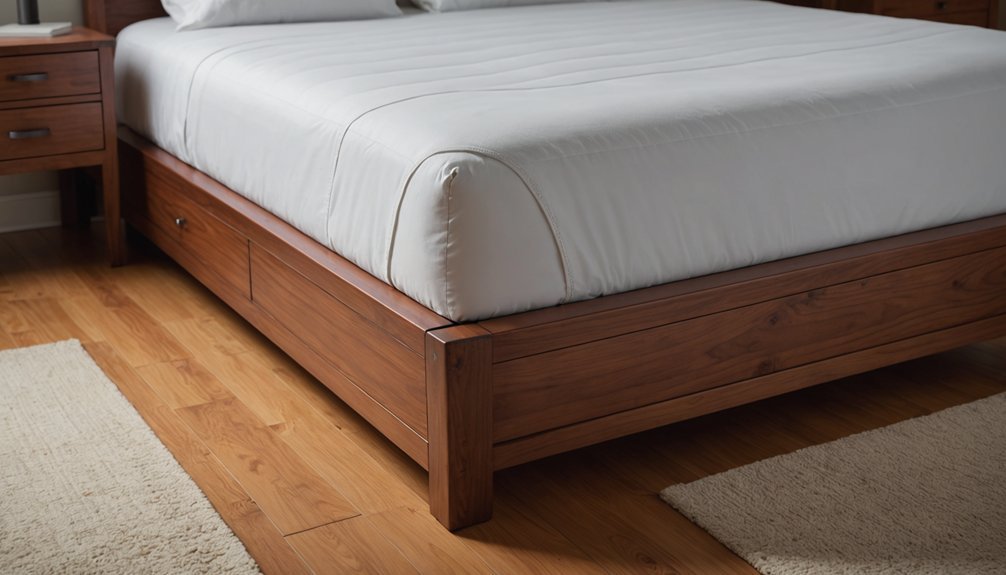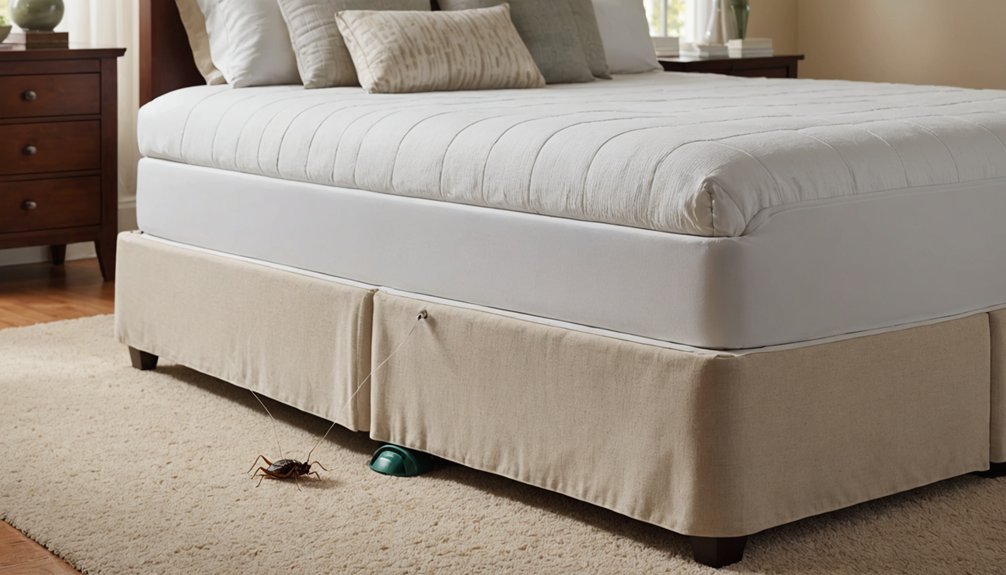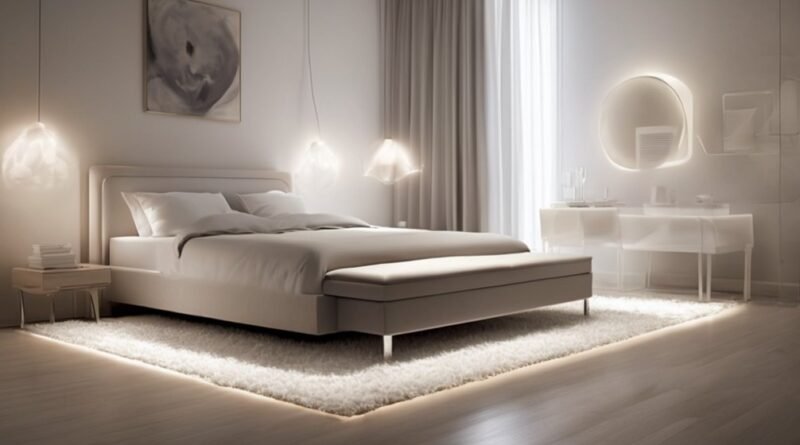Best Bed Bug Interceptor Traps: Setup & Results
When you’re battling bed bugs, interceptor traps can make the difference between success and endless frustration. You’ll find various designs on the market, from basic plastic dishes to sophisticated dual-wall systems, each promising to catch these persistent pests. While setting up these traps might seem straightforward, there’s more to proper placement and maintenance than meets the eye – and your success rate depends entirely on getting these essential details right.
Key Takeaways
- ClimbUp interceptors with dual-ring systems are among the most effective, featuring double-walled dishes and talcum powder for maximum trapping.
- Place interceptors under each bed leg, ensure furniture is isolated, and eliminate wall contact for optimal trap performance.
- Regular maintenance includes weekly talcum powder reapplication, monthly cleaning, and frequent inspection of captured bugs using a flashlight.
- Scientific studies show interceptors can eliminate 50% of low-level infestations within 16 weeks when used consistently.
- Black or red traps with deep pitfall wells and CO2 attractants achieve the highest capture rates in controlled tests.
Understanding Different Types of Bed Bug Interceptors

The world of bed bug interceptors encompasses several distinct categories, each designed to trap these persistent pests before they reach your sleeping areas.
Mechanical interceptors are the most common type, featuring double-walled plastic dishes coated with talcum powder that create slippery surfaces to prevent escape. Effectiveness rated high when placed properly under furniture legs and bed posts.
Double-walled interceptors with talcum-coated surfaces remain the gold standard for trapping bed bugs before they reach your bed.
You’ll find commercial options like ClimbUp interceptors, which use a dual-ring system – an outer ring catches bugs climbing up from the floor, while an inner well traps those descending from furniture.
DIY alternatives can be crafted using nested plastic containers and talcum powder, offering a budget-friendly solution.
While light and ultrasonic traps exist, they’re less effective than physical interceptors.
Setting Up Your Interceptor Traps Effectively

You’ll maximize your bed bug interceptor traps‘ effectiveness by placing them strategically under each bed leg and near suspected infested furniture.
The dual moat system prevents bed bugs from climbing up furniture while trapping them in smooth-walled wells.
To maintain peak performance, lift bed legs slightly to guarantee traps fit snugly underneath, and eliminate any contact between your bed frame and walls or floor.
Regular monitoring and maintenance of your traps, including cleaning or replacing the talc coating, will guarantee continued effectiveness in capturing and detecting bed bugs.
Essential Placement Techniques
Successful bed bug interceptor placement hinges on three critical strategies: isolating furniture, targeting key zones, and securing against bypass routes. You’ll need to place interceptors under each furniture leg while ensuring no contact with walls or other objects.
Early detection is crucial since delaying action can make infestations harder and more expensive to control.
Key placement zones include:
- Directly beneath every bed and furniture leg, including center supports
- Along walls adjacent to sleeping areas
- Around room perimeters to monitor activity
- Near suspected infestation hotspots
- In easily accessible locations for regular inspection
For maximum effectiveness, lift bed linens off the floor and remove any alternate climbing paths.
Consider enhancing your traps with smooth tape on outer surfaces and using powdered barriers between nested containers.
Remember to keep furniture isolated and check that your interceptors remain level and stable to prevent bugs from finding alternative routes.
Maintaining Trap Performance
Once installed, bed bug interceptor traps require consistent maintenance to provide ideal performance and reliable monitoring. You’ll need to inspect your traps daily or several times weekly using a flashlight and magnifying glass. Keep the surfaces clean and free from dust, as debris can reduce effectiveness. Reapply talcum powder monthly after cleaning to maintain the slippery barrier. The traps feature a rough exterior surface that helps bed bugs climb in while preventing their escape.
| Maintenance Task | Frequency | Key Points |
|---|---|---|
| Visual Inspection | Daily/Weekly | Use flashlight and magnifying glass |
| Clean Surfaces | Monthly | Remove dust and dead insects |
| Check Powder | Weekly | Reapply when surfaces become slick |
| Monitor Captures | Ongoing | Record number of bugs caught |
| Check Positioning | Weekly | Confirm furniture legs remain centered |
Remember to maintain proper furniture placement and keep bedding off the floor to prevent bugs from finding alternative routes. Continue using traps for several months after treatment to verify complete elimination.
Proven Results and Success Rates

Research has shown that bed bug interceptor traps deliver measurable results in both monitoring and control efforts. Daily capture rates range from 0.07% to 0.61% per interceptor, with higher success when CO2 attractants are used. Professional pest control companies report that bed bug cases increased by 64% in recent years, highlighting the growing need for effective monitoring solutions.
In real-world trials, continuous interceptor use combined with monitoring achieved elimination in 50% of low-level infestations within 16 weeks.
When using interceptors with other control methods, you’ll see success rates of:
- Up to 100% elimination over 22 weeks with consistent monitoring
- 7.2 times higher catches when using baited versus non-baited traps
- 0.55% daily capture rates with CO2 attractants
- 87% elimination success with combination treatments
- 99% recapture rates in controlled environments
For best results, combine interceptors with thorough treatment strategies and maintain consistent monitoring practices.
Maintenance Tips for Long-Term Protection
Maintaining bed bug interceptor traps requires consistent attention to detail and regular upkeep for peak performance. You’ll need to clean your traps every 2-4 weeks, removing captured bugs and debris that could compromise effectiveness. Check for damage regularly and replace traps showing cracks or wear.
| Maintenance Task | Frequency | Key Action |
|---|---|---|
| Basic Cleaning | Every 2-4 weeks | Remove debris, bugs |
| Inspection | Daily/nightly | Use flashlight, check both wells |
| Surface Treatment | Monthly | Reapply talcum/car polish |
| Damage Check | Weekly | Look for cracks, deformation |
Don’t let bedding touch the floor, and make sure furniture legs remain centered in traps. Track your findings in a monitoring log to identify patterns and assess treatment success. Keep spare traps ready for quick replacement when needed, and maintain a thin layer of talcum powder to enhance trap performance without hindering visibility.
Cost Analysis and Value Comparison
When choosing bed bug interceptor traps, you’ll need to balance initial costs against long-term value. ClimbUp interceptors offer excellent value at $5-7 per unit, with bulk discounts available for larger sets. A 12-pack costing $40-51 can protect three standard beds, making them cost-effective for most homes.
Consider these key factors when evaluating trap costs:
- ClimbUp’s crack-resistant polypropylene construction guarantees durability without frequent replacements
- Reusable options like Biocare First Response ($26-32) may save money over time
- Premium options like SenSci Volcano ($100+) include active lures but cost considerably more
- Basic disposable traps start around $4-7 but require regular replacement
- Some systems need ongoing purchases of replacement lures or baits
Choose based on your infestation level and budget constraints while factoring in long-term maintenance costs.
Common Setup Mistakes to Avoid
Despite their simple design, bed bug interceptor traps can fail if you don’t set them up correctly. You’ll need enough traps for every furniture leg, as missing even one can let bed bugs bypass your defenses.
Keep your furniture away from walls and verify bedding doesn’t touch the floor – these contact points give bugs alternative routes around your traps.
Choose containers that fit your furniture legs properly and maintain them with regular talcum powder applications. Don’t forget to empty and clean them periodically to prevent overcrowding.
Place traps strategically under all infested furniture and near known bed bug hiding spots, not just under beds.
Remember that interceptors aren’t a standalone solution. You’ll need to combine them with other treatment methods and regular inspections for effective bed bug control.
Scientific Evidence and Research Findings
Research studies have consistently demonstrated the effectiveness of bed bug interceptor traps, particularly when enhanced with strategic design elements. These traps not only capture bed bugs but also help to monitor and prevent infestations proactively. As advancements in design and technology continue, experts anticipate that the best bed bug interceptors of 2025 will incorporate innovative features to improve detection and ease of use. This evolution may significantly enhance the overall efficacy of pest management strategies in residential and commercial settings.
Scientific findings show that CO2 release rates directly impact trap success, with higher rates of 800 mL/min proving most effective at capturing bed bugs.
Key research-backed features that increase trap effectiveness include:
- Black or red coloring outperforms white traps
- Deeper pitfall wells improve bug retention rates
- Chemical lures can double capture success rates
- Moat-style designs prevent escape
- Combined CO2 and pheromone lures work synergistically
Studies confirm that properly designed interceptors can detect infestations early, even when visual inspections fail.
Whether using compressed CO2 or cost-effective sugar-yeast mixtures, these evidence-based design elements greatly enhance trap performance in both laboratory and real-world settings.
Conclusion
You’ll find bed bug interceptors to be a proven defense against these persistent pests. When you’ve installed them correctly and maintain them regularly, they’ll capture most bed bugs trying to reach your furniture. Don’t forget to check and clean your traps weekly, reapply talcum powder as needed, and combine them with other treatment methods. With proper setup and care, you’re looking at an 87% success rate in your bed bug battle.

